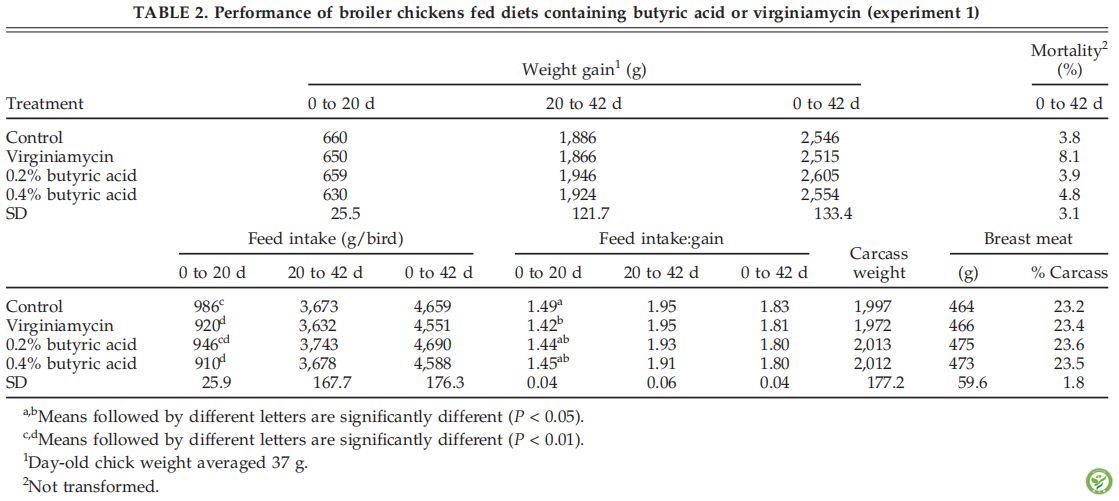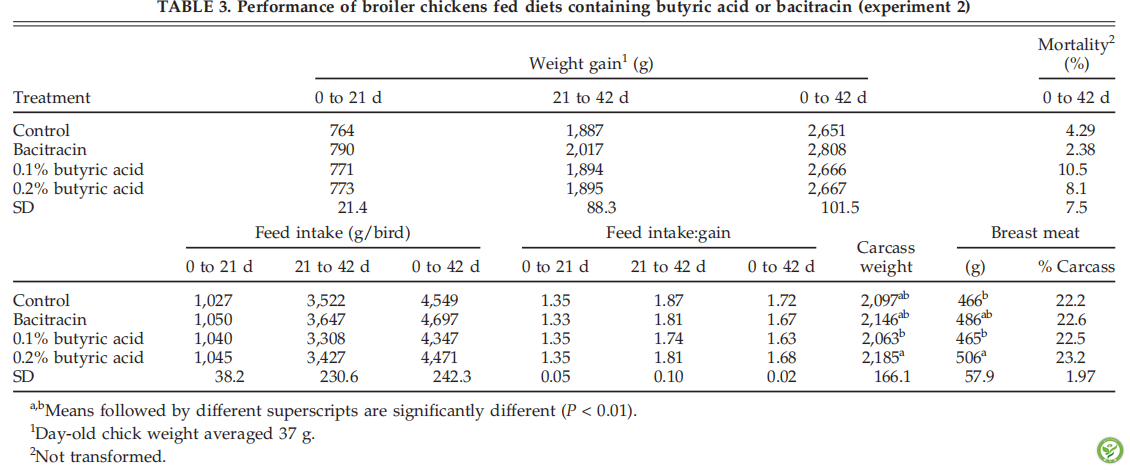第80期:丁酸显著增加肉鸡胴体重和胸肌和在球虫感染下生长性能更佳
Effect of Butyric Acid on the Performance and Carcass Yield of Broiler Chickens
作者:S. Leeson,*,1 H. Namkung,* M. Antongiovanni,† and E. H. Lee‡
*Department of Animal and Poultry Science, University of Guelph, Ontario, Canada N1G 2W1;
†Dipartimento di Scienze Zootecniche, Universita di Firenze, I50144; Firenze, Italy; and ‡Vetech Laboratories Inc., Guelph, Ontario, Canada N1K 1A8
来源:2005 Poultry Science 84:1418–1422
翻译:肠动力研究院 梁琦
【摘要】:短链脂肪酸(SCFAs)如丁酸被认为是抗生素生长促进剂的潜在替代品。本文旨在通过两个试验来探究丁酸对肉鸡性能和胴体特性的影响。此外,还研究了丁酸对抗球虫卵囊感染能力的影响。
实验一:840羽1日龄雄性Ross肉鸡被随机分配成4个处理组,对照组饲喂基础日粮;其他3个处理组分别饲喂基础日粮+11 ppm维吉尼亚霉素或0.2%丁酸或0.4%丁酸,每组35羽,6个重复,试验为期42天,试验结束后每组随机取8羽鸡致死并分析胴体特性。
实验二:本试验的试验设计、动物数量和管理方式均和试验一相同,对照组饲喂基础日粮,其他3个处理组分别饲喂50 ppm杆菌肽(杆菌肽亚甲基二水杨酸酯)或0.1%丁酸或0.2%丁酸。随后收集部分肉鸡的十二指肠样品,并固定在10%缓冲的福尔马林溶液当中,之后对其进行HE染色并评估样品的绒毛长度和隐窝深度。
实验三:40羽21日龄的肉鸡被用于球虫感染的研究。40羽肉鸡在1日龄时接种球虫疫苗,并饲喂基础饲粮或含有0.2%丁酸的饲粮至21天。而在第21天分别用不同浓度的球虫混合物来感染肉鸡,并在6天后比较感染前后肉鸡的重量变化,感染期间饲喂的日粮均为基础日粮,第27天计算肉鸡的死亡率和观察盲肠病变情况。
结果显示,在实验一中,不同日粮处理对肉鸡的体重增加没有显著影响;与试验初期饲喂对照日粮的肉鸡相比,饲喂含有0.4%丁酸日粮的肉鸡的采食量显著降低(P <0.01),而喂食0.2%丁酸的肉鸡的采食量与对照组相似。而在实验二中,日粮处理并不影响肉鸡的生产性能,而在饲喂0.2%丁酸的肉鸡中,其胴体重和胸肌产量却显著增加(P <0.01)。在球虫卵囊感染的前提下,与饲喂对照饲粮的肉鸡相比,感染前饲喂丁酸的肉鸡在感染后显示出更高的生长速率。杆菌肽显著降低肉鸡的十二指肠绒毛隐窝深度(P <0.05),而绒毛长度在饲喂含有丁酸或基础日粮的肉鸡中相似。
研究结果表明,饲喂含有0.2%丁酸的日粮可维持肉鸡的生产性能和胴体品质,尤其是接种球虫疫苗而受感染的肉鸡。
以下是相关图表
表1:日粮的组成

表2:饲喂含有丁酸或维吉尼亚霉素日粮的肉鸡的生产性能(实验1)

表3:饲喂含有丁酸或杆菌肽日粮的肉鸡的生产性能(实验2)

表4:十二指肠的形态学(实验2)和球虫卵囊感染下,第21-27天的体重增加量(实验3)

结论
以上研究结果表明,在整个42天的肉鸡生长期内,饲喂高达0.4%的丁酸甘油酯没有负面影响。有迹象表明,与抗生素不同的是,丁酸有助于维持肉鸡肠绒毛结构,以及喂食丁酸可减少球虫感染的破坏性影响。然而需要进一步来研究丁酸的剂量反应,以及饲喂该产品所需的具体时间。单丁酸甘油酯,二丁酸甘油酯和三丁酸甘油酯的混合物似乎提供了通过肉鸡饲料来供给丁酸的替代途径。
Abstract
Short-chain fatty acids such as butyrate are considered potential alternatives to antibiotic growth promoters. The effificacy of butyric acid on performance and carcass characteristics of broiler chickens was tested in two studies. The effect of dietary butyrate on the ability to withstand coccidial oocyte challenge also was investigated. In experiment 1, male broiler chickens were fed diets supplemented with 0 or 11 ppm virginiamycin or 0.2 or 0.4% butyric acid (as mono-, di-, and triglyceride). In experiment 2, broilers were fed bacitracin methylene disalicylate or 0.1 or 0.2% butyric acid. In another trial, birds vaccinated against coccidiosis were challenged with oocytes at 21 d and examined 6 d later. In experiment 1, diet treatments had no effect on body weight gain. Feed intake of the birds fed 0.4% butyric acid was decreased(P < 0.01) compared with birds fed the nonmedicated diet during the starter period, whereas birds fed 0.2% butyric acid had similar feed intake to the control birds. In experiment 2, diet treatments did not affect the performance of broiler chicks while carcass weight and breast meat yield increased (P < 0.01) in birds fed 0.2% butyric acid. With oocyte challenge, birds that had received butyric acid before challenge showed higher growth rate following the challenge compared with birds that received nonmed icated feed. Bacitracin decreased (P < 0.05%) duodenal villi crypt depth, whereas villus length was similar in birds fed butyric acid or the nonmedicated control diet. These results show that 0.2% butyric acid can help to maintain the performance and carcass quality of broilers, especially in vaccinated birds challenged with coccidiosis.
Conclusion
The results of these studies indicate no negative effect of feeding up to 0.4% butyrate glycerides throughout the 42-d broiler growth period. There is an indication that unlike antibiotics, butyrate helps in the maintenance of intestinal villi structure, compared with the negative effect of antibiotics, and that prior treatment reduces the
devastating effects of coccidial challenge. Further studies are warranted to study the dose response to butyric acid, and the specifific time needed to feed this product. A
mixture of butyrate mono-, di-, and triglyerides seems to provide an alternative route for administering butyric acid via the feed of broiler chickens.
如您需原文,请联系本文作者和出版方,或请垂询肠动力研究院。本网站发布的所有资料将尽最大可能注明出处、作者及日期,如无意中侵犯了您的知识产权,请来信及时告知,我们将立即予以删除。
All information released by the WeChat Official Account will do its best to indicate the source, author and date. If we inadvertently infringe on your intellectual property, please inform us in time and we will delete it immediately.



